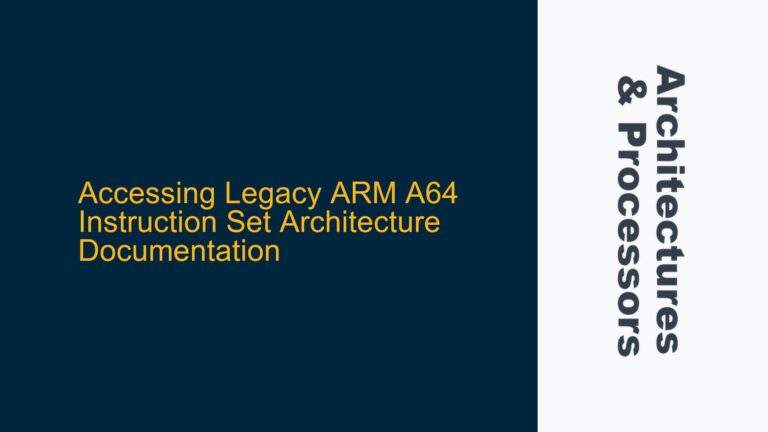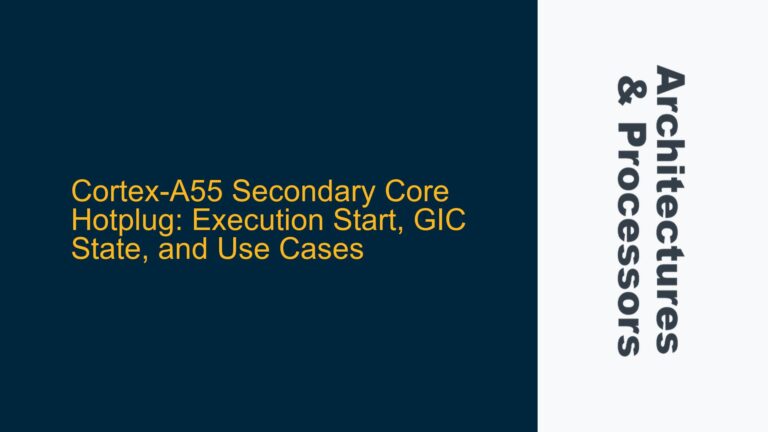ARM Cortex-M4 Integer Sign Function Performance Bottlenecks
The integer sign function, which returns +1 for positive values, -1 for negative values, and 0 for zero, is a common operation in embedded systems. On ARM Cortex-M4 processors, implementing this function efficiently requires a deep understanding of the architecture’s instruction set, pipeline behavior, and conditional execution capabilities. The Cortex-M4, being a member of the ARMv7-M architecture, supports Thumb-2 instructions, which blend 16-bit and 32-bit instructions to optimize code density and performance. However, the initial implementation provided, while functional, may not fully leverage the Cortex-M4’s capabilities, leading to suboptimal performance.
The provided assembly implementation uses a series of compare (CMP), conditional move (MOVNE, MOVMI), and branch (BX) instructions. While this approach is straightforward, it may not be the most efficient in terms of cycle count or instruction throughput. The Cortex-M4’s pipeline can execute certain instructions in parallel, and its conditional execution features can be exploited to reduce branch penalties. Additionally, the use of the IT (If-Then) block, which predicates subsequent instructions, introduces overhead that might be avoidable with a more optimized sequence.
Understanding the Cortex-M4’s instruction timing and pipeline behavior is crucial. The CMP instruction takes one cycle, and the MOVNE/MOVMI instructions each take one cycle if the condition is met. The IT block itself does not consume cycles but affects the scheduling of subsequent instructions. The BX instruction, used to return from the function, typically takes two cycles due to the pipeline flush associated with branching. Therefore, the current implementation could take up to five cycles in the worst-case scenario, depending on the input value.
Instruction Selection and Pipeline Utilization
One of the primary reasons for potential inefficiency in the initial implementation is the choice of instructions and their interaction with the Cortex-M4 pipeline. The Cortex-M4 features a three-stage pipeline (Fetch, Decode, Execute), and certain instructions can be executed in parallel or with reduced latency if scheduled correctly. The CMP instruction, for example, modifies the flags but does not require a destination register, allowing subsequent conditional instructions to execute without additional latency.
The use of the IT block, while necessary for conditional execution, can introduce inefficiencies. The IT block predicates up to four subsequent instructions, but it requires careful scheduling to avoid pipeline stalls. In the provided code, the IT block is used twice, once for the MOVNE instruction and once for the MOVMI instruction. This dual use of the IT block can lead to suboptimal instruction scheduling, as the processor must wait for the condition to be evaluated before proceeding with the next instruction.
Another consideration is the use of the MOVNE and MOVMI instructions. While these instructions are straightforward, they may not be the most efficient way to achieve the desired result. The Cortex-M4 supports a range of arithmetic and logical operations that can be used to manipulate the input value directly, potentially reducing the number of instructions required. For example, the ASR (Arithmetic Shift Right) instruction can be used to propagate the sign bit, and the ADD instruction can be used to adjust the result accordingly.
Optimized Assembly Implementation and Cycle Count Reduction
To optimize the integer sign function on the Cortex-M4, we can explore alternative instruction sequences that reduce the cycle count and improve pipeline utilization. One approach is to eliminate the use of the IT block by leveraging the Cortex-M4’s conditional execution capabilities directly. This can be achieved by using instructions that implicitly set or use the condition flags, allowing for more efficient scheduling.
An optimized implementation might look like this:
__asm static int Sign(int x)
{
CMP r0, #0 // Compare input with 0
BEQ zero_case // Branch if input is zero
ASR r1, r0, #31 // Arithmetic shift right to propagate sign bit
ADD r0, r1, #1 // Adjust result based on sign bit
BX lr // Return from function
zero_case:
MOV r0, #0 // Set result to 0
BX lr // Return from function
}
In this optimized version, the CMP instruction is used to compare the input with zero, and the BEQ instruction branches to the zero_case label if the input is zero. This eliminates the need for the first IT block and reduces the number of instructions executed in the common case. The ASR instruction is then used to propagate the sign bit of the input value, and the ADD instruction adjusts the result based on the sign bit. This sequence reduces the number of instructions and improves pipeline utilization, potentially reducing the cycle count.
The zero_case label handles the case where the input is zero, setting the result to 0 and returning from the function. This approach ensures that the function returns the correct result in all cases while minimizing the number of instructions executed. The BX instruction is used to return from the function, and its two-cycle latency is unavoidable due to the pipeline flush associated with branching.
By carefully selecting instructions and optimizing the instruction sequence, we can reduce the cycle count and improve the performance of the integer sign function on the Cortex-M4. This optimized implementation takes advantage of the Cortex-M4’s conditional execution capabilities and pipeline behavior, resulting in a more efficient and performant solution.






